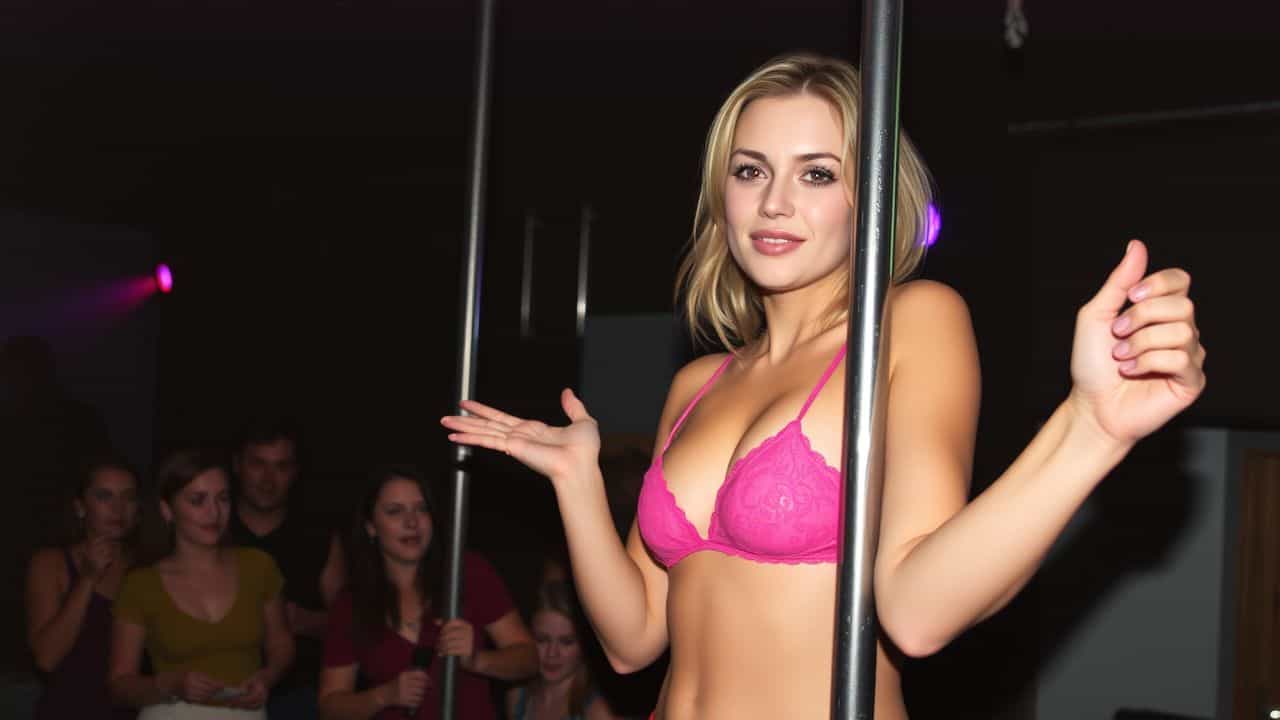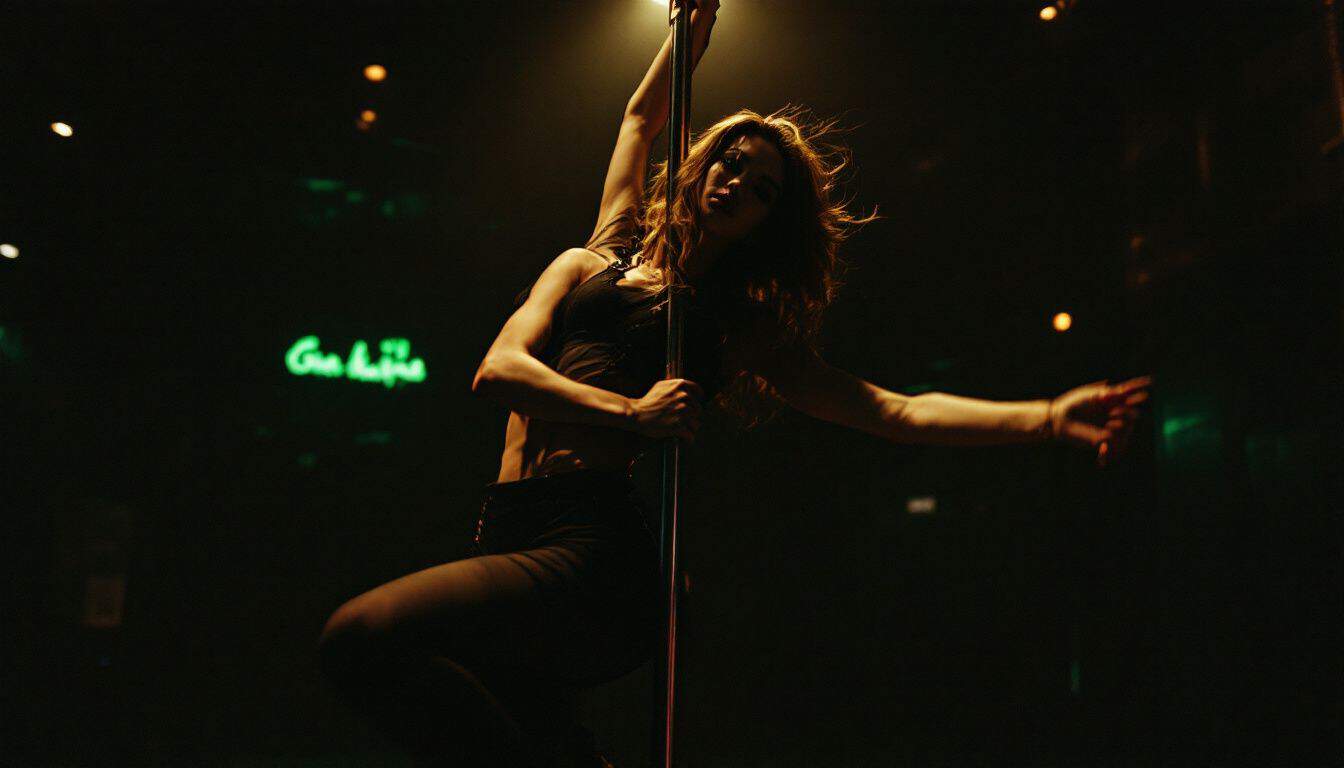Curious about how much do strippers make, and if it’s enough to pay your bills? Stripper salary varies widely—with dancers earning around $400 a night or averaging up to $76,800 each year.
This post will uncover six key factors that shape stripper income: location, club type, skills needed, and more. Read on for clear facts that may surprise you!
Key Takeaways
Strippers typically make about $400 a night, totaling around $76,800 a year—though actual income varies greatly based on city, club type, personal abilities, and how often they work.
Performers in major cities, such as Las Vegas, New York, and Miami, usually earn higher incomes than dancers based in smaller towns, with top talents at high-end establishments pulling in over $500 for a four-hour shift.
The highest-earning dancers average roughly $875 per week (about $21 per hour), or approximately $3,036 each month—and dancers in the top 10% can reach annual earnings of around $45,500.
Personal skills significantly boost income, since dancers who excel at pole routines, connect easily with customers, and nurture an active social media following tend to gather better tips.
Earnings differ strongly from one state to another—for instance, in Newfoundland, dancers earn roughly 14.9% more than average, about $41,862 per year—with projected salaries there likely hitting around $36,442 annually by 2025.
Table of Contents
Factors That Influence Stripper Earnings

Stripper income varies based on several key factors that can make or break earning potential. Your pay as an exotic dancer depends on the club’s location, your shift times, and your personal stage presence.
Location and State

The place you dance greatly impacts your paycheck. Popular clubs in big cities—such as Las Vegas, New York, and Miami—pay far better than smaller venues elsewhere. Statistics clearly back this up: dancers in Newfoundland earn around $5,420 more per year than the average annual salary of $36,442, about 14.9% higher.
Dancers in Yukon Territory do pretty well too, making 13.8% more than average. Regional pay gaps happen because wealthier areas have customers who tip generously and spend plenty on private dances.
Even club location within the city matters. Spots close to business areas or tourist attractions often draw bigger spenders. I’ve danced in both small towns and bustling cities, and in urban areas my tips usually doubled compared to rural gigs.
Many successful dancers move around the country, chasing better opportunities in states with good pay and cheaper living costs at the same time. If you’re planning to become a stripper, check out the 29 states paying above the national average to find the best earning potential for you.
Type of Venue or Club

Strip clubs vary a lot in how and how much they pay their dancers. Upscale venues in big cities usually pay far better than smaller clubs in towns and suburbs. Dancers at high-end spots regularly take home around $400 or more each night, while performers at more casual places might earn about half that amount.
I’ve danced at both types, across my career, and saw these differences clearly. A club’s reputation strongly affects the amount you’ll end up earning.
Your venue choice can mean the difference between a $500 four-hour shift and barely covering your house fee.
Private parties and select events typically pay even more than regular shifts at clubs. These special bookings usually take place in top hotels, fancy residences, or upscale neighborhoods.
Many dancers boost their incomes by balancing regular club nights with these private events. How much you make also depends on club rules about tips, fees, and house charges. Next up, we’ll look into how your dancing schedule affects your overall earnings.
Work Schedule and Hours

Strippers typically take home more money by working longer weekly hours. Top earners bring in around $875 weekly—that’s roughly $21 per hour—with monthly average earnings hitting about $3,036.
Many exotic dancers prefer night and weekend shifts, since that’s when clubs tend to draw larger crowds. Choosing your shift wisely matters: prime weekend evenings often mean better tips compared to quieter weekday afternoons.
Even dancers in smaller regions, like Duncan, BC, and Northwest Territories, usually work part-time yet still make decent money. If this job market appeals to you, picking up extra shifts or extending your work hours can significantly increase your weekly earnings.
Unsure if this career path aligns with your long-term goals? This resource can help you decide whether it’s a good fit.
Individual Skills and Appearance

Outside your working hours, personal talents and appearance greatly influence earnings. Dancers who master advanced pole tricks or present unique routines usually get larger tips compared to those performing standard moves.
Confidence on stage matters a lot—eye contact, boldness, and charisma boost your income significantly. High-earning dancers often develop loyal followings, with fans returning regularly just to watch them perform.
Physical appearance does affect income, but maybe not how you’d expect. Attractive looks do count—but genuine rapport with clients often matters even more. Customers, particularly regular patrons and VIP guests, tend to give bigger tips if they feel a real connection.
Building your brand on platforms like Instagram or TikTok can also bring new followers into your workplace. Floor performers who excel at both impressive dance skills and friendly customer interaction regularly earn top money in the club environment.
Average Stripper Salaries by State

Dancer earnings vary dramatically across different regions in North America. Geographic location plays a major role in how much exotic dancers take home. The tables below show the breakdown of exotic dancer pay across various states and provinces.
| Canadian Province | Annual Salary | Monthly Pay | Weekly Pay | Hourly Wage |
|---|---|---|---|---|
| Newfoundland | $41,862 | $3,488 | $805 | $20.13 |
| Nova Scotia | $41,487 | $3,457 | $797 | $19.95 |
| Yukon Territory | $41,487 | $3,457 | $797 | $19.95 |
| Saskatchewan | $41,487 | $3,457 | $797 | $19.95 |
| Quebec | $41,487 | $3,457 | $797 | $19.95 |
| U.S. State | Annual Salary Range |
|---|---|
| Washington | $27,233 – $41,862 |
| New York | $30,000 – $45,000 |
| Massachusetts | $29,500 – $43,000 |
| Florida | $28,000 – $42,000 |
| Income Percentile | Annual Salary |
|---|---|
| Minimum | $22,500 |
| 25th Percentile | $32,000 |
| 75th Percentile | $40,000 |
| 90th Percentile | $45,500 |
| Maximum | $49,000 |
Money earned by performers often goes unreported. Cash tips make up a large portion of income, which can lead to incomplete salary data. Girls working in upscale venues in major cities tend to earn on the higher end of these ranges. Experience level creates significant pay differences – seasoned performers typically earn much more than newcomers.
Tips for Maximizing Stripper Income

Smart dancers can boost their income with proven methods that work in today’s club scene. Money-making tricks range from mastering pole skills to building a loyal customer base through social media platforms like Facebook and Twitter.
Finding High-Paying Clubs

Figuring out which clubs offer the best pay takes time—and some digging around. Usually, the highest-paid dancers perform at upscale spots in big cities, where clients spend generously on tips and VIP rooms.
For instance, dancers in Kentville can pull in about $45,708 yearly, while over in Whitehorse they make roughly $45,418 per year. Where your club sits—and how pricey the area is—directly affects how much you’ll earn.
Floor technicians even swap salary comparisons on social media platforms such as Facebook, Twitter, and YouTube to hunt down better gigs.
Client type also plays a huge role in your paycheck. Clubs that draw wealthier crowds generally mean better tips and steadier cash flow for dancers. Last year, I performed at three different clubs and noticed a nice bump of nearly $300 extra each week at venues providing VIP rooms.
Private rooms help dancers from all backgrounds—including Native American and Caucasian artists—to earn steadier money instead of only counting on stage tips each night. Clubs down in southern regions usually pay less compared with places that have high living costs—Nunavut or Labrador, for instance—where factors like breast size matter far less than actual dancing skills.
Enhancing Skills and Presentation

Pole dancing classes give adult entertainers a clear advantage in boosting their income. Mastering advanced moves draws more attention from customers and increases tips significantly.
Good classes help dancers improve their skills and confidence on stage—customers appreciate and reward this visibly improved performance. Many exotic dancers even report a noticeable boost in earnings after completing professional training.
The dancers who invest in their craft are the ones who take home the most cash.
Physical appearance counts just as much as dancing talent. Successful dancers spend money on attractive outfits and professional dancer shoes to elevate their stage look. Taking extra care with grooming completes the attractive presence customers willingly pay more for.
According to the salary calculator, dancers who invest effort in their appearance earn as much as 40% more than performers who neglect this area—even at clubs with comparable living costs.
Challenges in Estimating Stripper Income

Figuring out exactly how much exotic dancers earn can get tricky fast. Clubs typically pay dancers in cash each night, so clear records are pretty rare. From my own experience, hourly pay can bounce between $20 and over $100, depending purely on skill and stage presence.
With tips driving the income, earnings are often unpredictable—one dancer might earn more than $1,000 on a busy Saturday night but barely scrape together gas money the following Tuesday.
All this makes filing accurate taxes challenging, so dancers often end up with incomplete financial records.
Another issue is the varied cost of living across states, which directly influences how far a dancer’s income can go. Clubs also differ a lot in the fees they charge dancers to work each shift—some take hefty portions from performers, even if they’re just wearing pasties.
Unlike steady-paycheck jobs, dancing comes with income uncertainty, driven by customer mood, local weather, and events happening nearby. To make matters tougher, certain clubs have even talked about replacing human performers with lifelike androids, adding worries about job stability on top of an already complicated income situation.
How Will Stripper Earnings Evolve in 2025?

Stripper earnings are set to rise notably in 2025. Many dancers will pull in around $36,442 a year—or roughly $17.52 per hour. This steady pay increase reflects shifting public attitudes and stronger demand at clubs.
Still, a wide pay gap remains: the top-earning performers can make up to $45,500 a year. That’s about $3,791 per month, around $875 every week for highly skilled dancers. Location matters greatly too, as urban clubs tend to offer better pay than rural spots.
Several factors drive fair pay for striptease dancers. A dancer’s level of experience, the club’s status, and local regulations all affect overall earnings. Many performers now leverage social media to boost their image and draw in higher-paying patrons.
Plus, digital tipping apps have streamlined payments, encouraging clients to tip better and more often. Economic shifts may bring hurdles along with fresh opportunities. Dancers who stay on top of trends and sharpen their skills will most likely achieve top-tier earnings in 2025.
People Also Ask
How much money do striptease artists usually earn?
Striptease artists typically earn around $100 to $1,000 each night, but this can vary a lot. Factors like location, club type, and the individual’s skills strongly influence their nightly earnings.
What affects how much money ecdysiasts make?
Club location often has the largest impact on earnings. Other significant factors include appearance, dance and performance ability, customer interaction skills, and scheduling flexibility. Private dances or VIP room services can also boost their income.
Do striptease artists earn more money working weekends?
Yes, striptease artists generally earn more money on weekends. Clubs usually draw larger crowds on Friday and Saturday nights—customers often spend generously during those peak times.
Can ecdysiasts earn enough money for a long-term career?
Many ecdysiasts see dancing as temporary, partly because it can be physically tiring. Top earners usually have strong performances, provide good customer experiences, and manage their finances wisely. Some dancers save up the money they make to invest in school or launch their own businesses.
References
https://www.wiggleclub.com/how-much-do-strippers-make-raking-in-big-bucks-and-living-the-high-life/
https://www.businessinsider.com/how-much-strippers-make-2018-5
https://thefinancialdiet.com/financial-realities-stripping-living/
https://www.ziprecruiter.com/Salaries/What-Is-the-Average-Stripper-Salary-by-State
https://www.comparably.com/salaries/salaries-for-stripper (2023-11-16)
